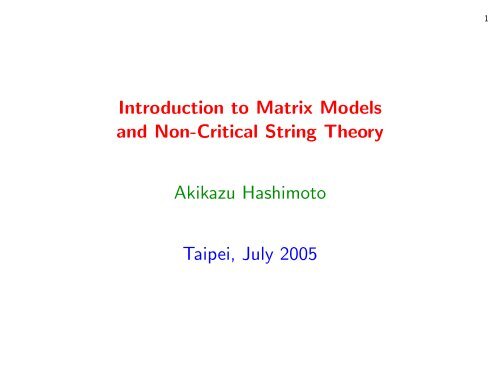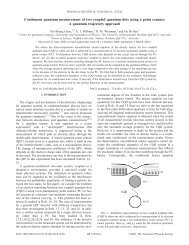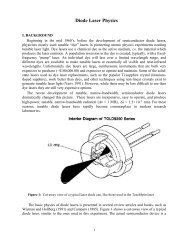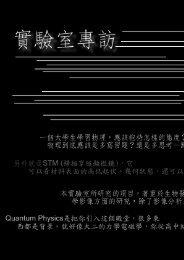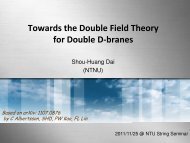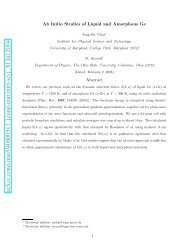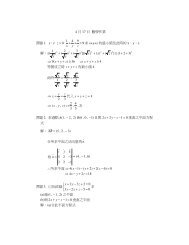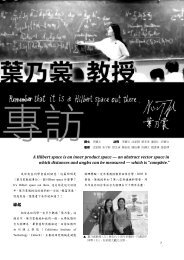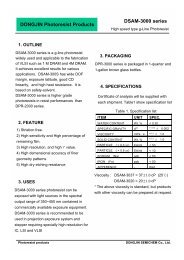Introduction to Matrix Models and Non-Critical String Theory Akikazu ...
Introduction to Matrix Models and Non-Critical String Theory Akikazu ...
Introduction to Matrix Models and Non-Critical String Theory Akikazu ...
Create successful ePaper yourself
Turn your PDF publications into a flip-book with our unique Google optimized e-Paper software.
1<strong>Introduction</strong> <strong>to</strong> <strong>Matrix</strong> <strong>Models</strong><strong>and</strong> <strong>Non</strong>-<strong>Critical</strong> <strong>String</strong> <strong>Theory</strong><strong>Akikazu</strong> Hashimo<strong>to</strong>Taipei, July 2005
2These lectures are meant <strong>to</strong> provide pedagogicalintroduction <strong>to</strong> continuum <strong>and</strong> matrix model formulationof non-critical string theoryThey typically describe strings in 1+0 or 1+1 dimensionswith a linear dila<strong>to</strong>n. They are important because:• Exactly Solvable• Context <strong>to</strong> explore non-perturbative issues(open/closed duality)• Appears <strong>to</strong> describe a sec<strong>to</strong>r of critical string theory• Have many connections <strong>to</strong> <strong>to</strong>pics in mathematics
3The subject is reviewed extensively in the literature• Brezin, Wadia (Collection of Reprints)• Di Francesco, Ginsparg, Zinn-Justin• Dijkgraaf• Ginsparg <strong>and</strong> Moore• Klebanov• Morozov• Seiberg, ShihWarning: “These theories are exactly solvable. Thatdoes not necessarily mean we underst<strong>and</strong> them.”
4Plan1) Review of Liouville <strong>Theory</strong> <strong>and</strong> <strong>Matrix</strong> Model2) Methods of Orthogonal Polynomials <strong>and</strong> KdVheirarchy3) Branes <strong>and</strong> open/closed string duality
5<strong>Non</strong>-critical string theoryBosonic string in d dimensions∫ Dg DXZ =1 ∫Vol(diff) e− 4πα ′ d 2 ξ √ gg µν ∂ µ X i ∂ ν X i , i = 0...d − 1Measure:∫∫∫Dge −1 2 |δg2| = 1, |δg 2 | = d 2 ξ √ g(g ac g bd − 2g ab g cd )δg ab δg cd∫DXe −|δX2| = 1, |δX 2 | = d 2 ξ √ gδX i δX iAction <strong>and</strong> measure are diffeomorphism invariant
6Gauge fix by chosing conformal gaugeg = e ϕ ĝ(τ)by introducing ghosts∫DbD¯bDcD¯c e −S ghS gh =∫d 2 ξ √ gb zz ∇¯z c z −b¯z¯z ∇ z c¯zUnder g → e σ g, the action is invariant, but the measuretransformsD g XD g (gh) → D e σ gXD e σ g(gh) = e d−2624πα ′S L(σ,g) D g XD g (gh)
7S L =∫dξ 2√ g( 12 gab ∂ a σ∂ b σ + Rσ + µe σ )This is the conformal anomaly which is cancelled bychosing d = 26Alternatively, make ϕ dynamical∫Dϕe − 1 ∫4πα ′ d 2 ξ √ ĝ( 25−d12 ĝab ∂ a ϕ∂ b ϕ+ 25−d6Then δĝ = ɛ(ξ)ĝ, δϕ = −ɛ(ξ) is a symmetryˆRϕ)
Rescale√25−d12 ϕ → ϕ∫Dϕe − 14πα ′ ∫d 2 ξ √ ĝ(ĝ ab ∂ a ϕ∂ b ϕ+Q ˆRϕ)8whereThe stress tensorQ =√25 − d3T = − 1 2 ∂ϕ∂ϕ + Q 2 ∂2 ϕ
9T (z)T (w) ∼ 1 c+ ..., c = 1 + 3Q22(z − w)4Finally, the µe γϕ term adjusted so that the opera<strong>to</strong>r hasdimension[e γϕ ] = − 1 γ(γ − Q) = 12So the bot<strong>to</strong>m line∫Dϕe − 1 ∫4πα ′ d 2 ξ √ ĝ(ĝ ab ∂ a ϕ∂ b ϕ+Q ˆRϕ+µe γϕ )γ = 1 √12( √ 25 − d ∓ √ 1 − d) = Q 2 ± 1 2√Q2 − 8
10pick branchγ = 1 √12( √ 25 − d − √ 1 − d) = Q 2 − 1 2√Q2 − 8so that in d → −∞ limit, γ → 0, so thatQ = 2/γ − γ → 2/γ, giving rise <strong>to</strong> “classical” Liouvilletheory∫S = d 2 ξ √ ĝ(ĝ ab ∂ a ϕ∂ b ϕ + Q ˆRϕ + µ )γ 2eγϕwhich is Weyl invariant under ĝ → e 2ρ ĝ, ϕ → ϕ − 2 γ ρ
11These can be coupled <strong>to</strong> d free bosons (or CFT withcentral charge c) so thatc matter + c liouv − 26 = 0c ≤ 1 <strong>and</strong> c ≥ 25 picked out because γ is real. At c = 25the signature of ϕ coordinate flips. We will focus onc ≤ 1 for which ϕ coordinate is Eucledean.• c < 1: 1 linear dila<strong>to</strong>n dimension• c = 1: 1 linear dila<strong>to</strong>n dimension, one flat direction
¡ ¡ ¡ ¡¡ ¡ ¡ ¡¡ ¡ ¡ ¡¡ ¡ ¡ ¡¡ ¡ ¡ ¡¡ ¡ ¡ ¡¡ ¡ ¡ ¡¡ ¡ ¡ ¡¡ ¡ ¡ ¡¡ ¡ ¡ ¡¡ ¡ ¡ ¡¡ ¡ ¡ ¡¡ ¡ ¡ ¡¡ ¡ ¡ ¡¡ ¡ ¡ ¡¡ ¡ ¡ ¡¡ ¡ ¡ ¡¡ ¡ ¡ ¡¡ ¡ ¡ ¡¡ ¡ ¡ ¡¡ ¡ ¡ ¡¡ ¡ ¡ ¡¡ ¡ ¡ ¡¡ ¡ ¡ ¡¡ ¡ ¡ ¡¡ ¡ ¡ ¡¡ ¡ ¡ ¡¡ ¡ ¡ ¡12linear dila<strong>to</strong>n: c.f. NS5-braneX¡ ¡ ¡ ¡¡ ¡ ¡ ¡¡ ¡ ¡ ¡φµe γϕ marginal tachyon condensateno X for c < 1, c = 1 is a barrier.
13Other interesting example: (p, q) Minimal CFT⎡⎤O 11 · · · O 1(p−1)O 21 O 2(p−1)6(p − q)2⎢⎥ c = 1 −⎣ . . ⎦pqO (q−1)1 · · · O (q−1)(p−1)• (p, q) = (2, 3): c = 0 pure gravity• (p, q) = (3, 4): c = 1/2 Ising Model• (p, q) = (2, 5): c = −22/5 Yang-Lee• Other (p, q): critical limits of various statistical models
14[O r,s ] = (pr − qs)2 − (p − q) 24pq• (3,2): ( 0 0 )• (4,3):( 1 12 1600 1 116 2)• (5,2): ( 0 − 1 5− 1 50 )
15Gravitational dressing[e αϕ O] = 1[O] = ∆ 0 , [e αϕ ] = − 1 √25 − d2 α(α − Q), Q = 3soα = √ 1 [ √25 √ ]− d − 1 − d + 24∆012α < Q 2 ,Seiberg Bound
16Some simple observables: <strong>String</strong> Susceptibility ΓLetZ(A) =∫DϕDX e −S δwhich for large A scales as(∫Z(A) ∼ A (Γ−2)χ/2−1<strong>String</strong> suceptibility is this scaling exponent.d 2 ξ √ )ĝe γϕ − ASimple scaling argument: Dϕ invariant underϕ → ϕ + ρ/γ
17Under this transformation∫Qd 2 ξ √ ĝ8πˆRϕ → Q ∫8πsoZ[A] ==∫∫DϕDXe −S e Qρχ2γ δd 2 ξ √ ĝ ˆRϕ + Q 8π(∫DϕDXe −S e Qρχ2γ −ρ δργ d2 ξ √ ĝ ˆRd 2 ξ √ )ĝe γϕ+ρ − A(∫d 2 ξ √ ĝe γϕ − e −ρ A= e Qρχ2γ −ρ Z[e −ρ A] = A − 2γ−1Z[1], Qχ<strong>and</strong> soΓ = 2 − Q γ = 1 [(d − 1) − √ ](d − 25)(d − 1)12)
18Along similar lines, one can define scaling dimension ∆ r,s1Z[A]∫DϕDXe −S δ(∫d 2 ξ √ ) ∫ĝe γϕ − Ad 2 ξ √ ĝe α r,sϕ O r,sFor ∆ 0 = (pr−qs)2 −(p−q) 24pq<strong>and</strong> c = 1 − 6(p−q)2pq,αγ = 1 − ∆ rs =p − q − |pr − qs|2q
19Physical observables are correlation functions of BRSTcohomologyFor L ⊗ M(p, q),H = {O n e α nϕ },O n : matter, ghosts, Liouvilleα nγ = p + q − n , n > 1, ≠ 0 mod q2qBRST cohomology has infinite element even thoughnumber of primary matter fields were finite.
20<strong>Matrix</strong> Model<strong>Theory</strong> of r<strong>and</strong>om matrces: (applications in disorderedsystems <strong>and</strong> quantum chaos)∫−TrV (M)Z = dMeM is hermitan N × N matrix. MeasureDM = ∏ ∏dM ii dM ij dMij∗i i
21ParametrizingM = U † ΛU,dM = dU ∏ idλ i ∆(λ) 2whereV<strong>and</strong>ermonde : ∆(λ) = ∏ i
22One way <strong>to</strong> see this. Let dU = idT U. Line element:TrdM 2= ∑ idM 2 ii + ∑ i
23Simplest <strong>Matrix</strong> Model: Gaussian ensumble∫∫∏Z = dMe −TrM 2 = dm i (m i − m j ) 2 e − ∑ i m2 i=∫i
24Large N limit described in terms of the eigenvaluedensity ρ(m).∫∫S = − dm m 2 ρ(m)+ dm dm ′ log(m−m ′ )ρ(m)ρ(m ′ )Equation of motionδS = −m 2 + 2∫dm ′ log(m − m ′ )ρ(m ′ ) = 0<strong>and</strong> differentiating with respect <strong>to</strong> m,∫m = dm ′ 1)m − m ′ρ(m′
25Solution:ρ(m) = 1 π√2N − m2Wigner semi-circule distributionρm
26One can also consider more general potential (BIPZ)e.g. V (M) = 1 2 M 2 + gM 4so that equation of motion becomes∫12 λ + 2gλ3 = dλ ′ 1)λ − λ ′ρ(λ′solved byρ(λ) = 1 π( ) 12 + 4ga2 + 2gλ2 √4a2N − λN2 , 12ga 4 + a 2 − 1 = 0
27Such generalization is interesting because the matrixaction∫dMe −TrM2 2 +gM3 3!can be represented in Feynman expansion↔ triangulation of 2D surface1/N expansion ↔ genus expansiong → g c ↔ continuum limit
28Resolvent: useful computational <strong>to</strong>ol∫Z =−NV (M)dMeChange integration variable M → M + 1M−ztransformationδdMNV (M)δe == −Tr( 1)M − z− NV ′ (M)M − zTr( 1)M − zUnder thisdM
29So we arrive at an identity( ) 1〈Tr TrM − z( 1M − z)〉 + 〈 NV ′ (M)M − z 〉 = 0In the large N limit, one can fac<strong>to</strong>rize( ) ( )11〈Tr 〉〈Tr 〉 + 〈 NV ′ (M)M − z M − z M − z 〉 = 0Schwinger-Dyson equation. A little rewriting:( ) ( )11〈Tr 〉〈Tr 〉 + NV ′ 1′(z)〈M − z M − zM − z 〉 = −〈NV (M) − NV ′ (z)〉M − z= N 2 f(z), Polynomial order p − 2
30Let’s denoteR(z) = 1 N Tr 1M − zThenR(z) 2 + R(z)V ′ (z) = f(z)For the simple case of V (M) = M 2 /2,R 2 + zR(z) = corR(z) = −z + √ 4c + z 22= −z + √ z 2 − 42
31• Constant c fixed by requirement thatR(z) = 1/z + O(z −2 )• R(z) imaginary for −2 < z < 2.ρ(z) = 1 √4 − z22πρm
32For the interacting cubic theoryone hasV = M 22 + gM 3R(z) = −V ′ (z) + √ V ′ (z) 2 + 4f2f = cz + d, <strong>and</strong> the descriminant is quartic in z. Arrangef so that descriminiant has two real roots <strong>and</strong> onedouble root.
33With this ansatz, one hasR(z) = − z + 3gz22+ (1 + 3g(a + b) + 3gz)√ (z − 2a)(z − 2b)2where3g(a−b) 2 +2(a+b)(1+3g(a+b)) = 0, (b−a) 2 (1+6g(a+b)) = 4so thatR(z) = 1 z + O(z−2 )This determines the eigenvalue distribution ρ(z) <strong>and</strong> itsolves the equation of motion.
34∫ 2b( )1F (0) = dλρ(λ)2a 2 λ2 + gλ 3 − 1 ∫dλdλ ′ ρ(λ)ρ(λ ′ ) ln(λ − λ ′ )2= − 1 σ(3σ 2 + 6σ + 2)3(1 + σ)(1 + 2σ) 2 + 1 ln(1 + 2σ)2whereσ = 3g(a + b)is a solution of18g 2 − σ(1 + σ)(1 + 2σ)with a bit more massagingF (0) = − ∑ k√1 (72g 2 ) k Γ(3k/2) 22(k + 2)! Γ(k/2 + 1) ≈ 3πk 7(108√ 3g 2 ) 2k
35Now, series∑kΓ−3( gg c) 2k= (g c − g) 2−ΓThe area scales likeA = g ∂ ∂g F (0)F (0) ∼ 1g c − gsoZ ∼ A Γ−2<strong>and</strong> we can read offΓ = − 7 2 + 3 = −1 2
36in agreement withΓ = 2 − Q γ = 1 12[(d − 1) − √ ](d − 25)(d − 1)for d = 0.
37All this was for pure 2D gravity (c = 0). What if we areinterested in adding conformal matter?Consider multi-matrix modelTr 1 2 A2 + 1 2 B2 + gA 3 + gB 3 + cABIsing model (c = 1/2 theory)
38Can also consider∫dt 1 2 (∂ tM) 2 + 1 2 M 2 + gM 3 (c = 1)Also consider adding higher order terms in the potentialV (M) = 1 2 M 2 + g 3 M 3 + g 4 M 4 + ...• Different discretization generically lead <strong>to</strong> samecontinuum limit (universality)• Fine tuning coupling gives rise <strong>to</strong> new critical behavior(multi-criticality)
39Double Scaling LimitIf one also compute 1/N corrections,F ∼ ∑ ∑N χ n (Γ−2)χ/2−1 (g/g c ) n ∼ (g c − g) (2−Γ)χ/2 N χχ nso scale g → g c keepingκ = (g c − g) (2−Γ)/2 N = fixedThenF = κ 2 F (0) + F (1) + κ −2 F (2) + ...
40Method of Orthogonal PolynomialsZ =∫dMe −TrV (M) =Because of anti-symmetry⎛∆(λ) = det(λ j−1i ) = det⎜⎝N∏i=1dλ ∆(λ) 2 e − ∑ i V (λ i)1 λ 1 λ 2 1 · · · λ N−111 λ 2 λ 2 2 · · · λ N−12. . . . .1 λ N−1 λ 2 N−1 · · · λN−1 N−1⎞⎟⎠
41Now, define a set of polynomialsP n (λ) = λ n + . . .satisfying orthogonality relation∫ ∞−∞e −V (λ) P n (λ)P m (λ) = h n δ mnThen,∆(λ) = det(λ j−1i ) = det(P j−1 (λ i ))
42<strong>and</strong>Z = N!N−1∏i=0h i = N!h N 0N−1∏i=1f N−kk, f k = h kh k−1Finding P n (<strong>and</strong> therefore h n ) is a finite procedure, so Zcan be computed exactlyIf interest is in large N limit,1N 2F = 1 ∑ ( 1 − k )ln f n ∼N Nwhere ξ = k/N.∫ 10dξ(1 − ξ) ln(f(ξ))
43Need f n for large n.This can be gotten from studying the recursion relationλP n (λ) =∑n+1c i P i (λ)but in facti=0λP n (λ) = P n+1 + r n P n−1becausefor i < n − 1.∫λP n (λ)P i (λ)e −V (λ) = 0
44Now,∫e −V (λ) (P n (λ)λ)P n−1 (λ) = r n h n−1∫= e −V (λ) P n (λ)(λP n−1 ) = h nsor n =h nh n−1= f n
45Similarly,∫=∫e −V (P ′ n(λ)λ)P n (λ) =e −V P ′ n(λ)(λP n (λ)) =∫∫= −∫=−e −V (nP n (λ) + . . .)P n (λ) = nh ne −V P n(λ)r ′ n P n−1 (λ)∫P n (λ)(r n e −V P n−1 ) ′r n P n (λ)P n−1 (λ)e −V V ′ (λ)∫P n (λ)r n e −V P n−1′sonh n = r n∫e −V V ′ (λ)P n (λ)P n−1 (λ)
46To apply these structures, consider for simplicity apotential with even terms onlyV = 1)(λ 2 + λ42g N + b λ6N 2ThenInsert this innh n = r n∫gV ′ = λ + 2λ3N+ 3bλ5N 2e −V V ′ (λ)P n (λ)P n−1 (λ)
47P n+1soλ : P n (λ) ↗ ↘r n P n−1gn = r n + 2 N r n(r n−1 + r n + r n+1 ) + 3bn2( 10 rrr terms)In the large n limit,ξ = n N ,r(ξ) = r nN
48<strong>and</strong>In general, ifthengξ = r + 6r 2 + 30br 3 ≡ W (r)V (λ) = 12g a pλ 2pW (r) = a p(2p − 1)!(p − 1)! 2rp
49For generic W (r),gξ = W (r) = g c + 1 2 W ′′ (r c )(r − r c ) 2 + ...Then r − r c ∼ (g c − ξg) −Γ with Γ = −1/2 sor = r c + (g c − ξg) −Γ , so that∫11N 2F =∼∫010dξ(1 − ξ)f(ξ)dξ (1 − ξ)(g c − ξg) −Γ ∼ (g c − g) −Γ+2Agree with Γ for pure gravity computed earlier.
50Multi-criticalityIn generalW (r) = g c + c(r − r c ) 2 → Γ = − 1 2W (r) = g c + c(r − r c ) 3 → Γ = − 1 3.W (r) = g c + c(r − r c ) m → Γ = − 1 mΓ = 2 −Qγ min=2, (p, q) = (2l + 1, 2)1 − p − q
51Now, if one is interested in higher-genus contributions,gξ = W (r) + 2r(ξ)(r(ξ + ɛ) + r(ξ − ɛ) − 2r(ξ))where ɛ = 1/N. Now scaleg c − ξg = a 2 zr − r c = au(z)N = a −5/2g − g c = κ −4/5 a 2⇒ z = u(z) 2 − 1 3 u′′ (z), u(κ −4/5 ) = Z ′′ (κ −4/5 )
52This is the KdV equation.Can be solved perturbativelyu = z 1/2 (1 − ∑ u k z −5/2k )( k= z 1/2 1 − 1 24 z−5/2 − 491152 z−5 − 1225 )6912 z−15/2 + ...<strong>and</strong> computes the genus expansion of Z
53Summary of Orthogonal PolynomialsZ =∫dMe −TrV (M) =∫N∏dλ ∆(λ)e − ∑ i V (λ i) ∆(λ)i=1|N〉 =N−1∏i=0S = S nm b † nb m ,det(P j−1 (λ i ))Z = 〈N|S|N〉S mn = δ mn h n
54KdV HeirarchyNormalize Π n so that∫dλe −V Π n Π m = δ nm<strong>and</strong> define Q nm by√hn+1λΠ n√hn−1= Π n + r n Π n−1h n h n= √ r n + 1Π n+1 + √ r n Π n−1 ≡ Q nm Π mQ nm = Q mn
55Along similar lines, define∂∂λ Π n = A nm Π mwhich has [Q, A] by definitnion. No particular symmetry∫0 = dλ ∂∂λ Π nΠ m e −V = (A nm + A mn − V ′ )Π n Π m e −V⇒ A + A T = V ′ (Q)P = A − 1 2 V ′ (Q) = 1 2 (A − AT ) is antisymmetric[P, Q] = 1
56In the double scaling limit, Q nm becomes a differentialopera<strong>to</strong>rAnticipate scalingThenQ = 2r 1/2cr(ξ) = r c + a 2 u(z)+ a2rc1/2(u + r c κ 2 ∂ 2 z) ∼ d 2 + uP = d 3 + 3 {u, d} Cubic in d4
57(2,3) model:1 = [P, Q] =( 34 u2 + 1 4 u′′ ) ′⇒ KdVP = (Q 3/2 ) +
58Orthogonal Polynomials, Lax Pairs, etc generlizesMulti-matrix modelZ =∫ n∏a=1dM a exp [−TrV a (M a ) + c a M a M a+1 ]are also solvable....
59Key identity: Itzykson-Zuber integral∫∫dAe TrV (A)+cAB ∆(a)= da ∑ i∆(b) e− i V (a i)+ca i b ithenZ =∫ n∏a=1dM a exp [−TrV a (M a ) + c a M a M a+1 ]=∫ n∏a=1dλ a ∆(λ 1 )e −S(λ a) ∆(λ n )
60Define biorthogonal polynomials∫ n∏a=1Π i (λ 1 )˜Π j (λ n )e −V a(λ a )+c a λ a λ a+1= δ nmfrom which one derivesQ = d q + {v q−2 (z), d q−2 } + {v q−4 (z), d q−4 } + . . . v 0 (z)<strong>and</strong> adjust V ’s such thatP = (Q) p/q+
61P = (Q p/q ) + , [P, Q] = 1defines differential equation for u(z)One can also turn on “coupling” t nP → P + 1 ∑nt n (Q n/q−1 ) +qGeneralized KdV flow equationn∂∂t nQ = [(Q n/q ) + , Q]
62Solve for u(z, t i ) = F ′′ (z, t i )τ = Z = e −Fis called the τ-function: compute correla<strong>to</strong>rsExpectation value of generic single trace opera<strong>to</strong>rTrf(M)computes insertion of integrated lowest dimensionopera<strong>to</strong>r. Fine tune for higher dimension opera<strong>to</strong>rs
63∂∂t nQ = [(Q n/q ) + , Q]α n ∼ p + q − nqγ ∼ α p−1,q−1 = 2⇒ α nγ = p + q − n2qcompare with BRST cohomology
64Alternative <strong>Matrix</strong> formulation of KdV flow∫ ]dM exp[−Tr 1 2 ΛM 2 + i M 3definee F(Λ) =Exp<strong>and</strong> in small t i∫ [dM exp −Tr12ΛM 2]t i (Λ) = −(2i − 1)!!TrΛ −2i−1ln τ = F = t3 06 + t 124 + t3 0t 16 + 1 24 t 0t 2 + t2 148 + ...6
65So we haveDouble Scaled <strong>Matrix</strong> Model (gauge theory)↕<strong>Non</strong>-critical string theory (gravity theory)↕Kontsevich <strong>Matrix</strong> Model (gauge theory)Can they be thought of as analogues of AdS/CFT in anyway?
66Think about D-branes• <strong>Matrix</strong> point of view1M TrΦM
67In double scaling limit1M ΦM = 1 M (2r c + a2√rcQ) MscaleM = 2r cla 2Then1M ΦM = 1 l elQ ⇐ 1 L TreLΦLaplace transform∫dL e −xL 1 L TreLΦ = Tr log(x − Φ)
68Differentiate wrt x1R(x) = Trx − Φis the resolventInterpret as insertion of boundary cosmologial constant∫d 2 ξ √ ĝ(ĝ ab ∂ a ϕ∂ b ϕ + Q ˆRϕ) ∫+ µe γϕ + Kϕ+µ B e γϕ/2These are branes considered by FZZ/T∂Σ
69What does the resolvent measure?1R(x) = TrΦ − x = ∑ i1λ i − xforce due <strong>to</strong> log interaction with other Eigenvaluesy ≡ V ′ (x) + 2R(x) = Effective Force∫ydx = Effective PotentialR(x) = −V ′ (x) + √ V ′ (x) 2 + 4f2
70For example for cubic potential theoryy 2 = (1 double root <strong>and</strong> pair of single root)In the continuum limit g 2 → 1/108 √ 3 the double rootapproach the cut....
71In this limit, one obtainsT 2 (y) = 2y 2 − 1 = x(4x 2 − 3) = T 3 (x)for the (2,3) model. Along limilar lines, (2, 2l + 1) modelgives rise <strong>to</strong> a cut <strong>and</strong> l stationary pointsT 2 (y) = T 2l+1 (x)....
72One arrives at a following global picture of 1-pointfunction of FZZT branexx
73CFT side: one has the Liouville Boundary StateΓ(1 + 2iP b)Γ(1 + 2iP/b) cos(2πσP )|µ B 〉 = µ −iP b |P 〉2 1/4 (−2iπP )µ B√ = cosh πbσ, b 2 = q µ pThese branes are semi-localizedΨ(ϕ) = 〈ϕ|µ B 〉 = e −µ Be bϕ φ=−(1/b)log( µB)
74CFT <strong>and</strong> <strong>Matrix</strong> Model agree e.g. annulus∫Z = dτZ ghost Z Lioville Z matterZ Liouville (τ) = 〈l 1 |e −τ(L 0+¯L 0 ) |l 2 〉Z(l 1 , l 2 ) ∼ ∑ k=1k sin(πk/q)Kkq(l 1 )Ikq(l 2 )Small l 2 limit: loops = ∑ BRST cohomology
75FZZT expectation value probe target space (as functionof µ B )xφ=−(1/b)log(µ B )....
76This picture is strictly perturbativeNice geometrical picture(Seiberg-Shih)• tachyon backgrounds deforming the Reimann sufracepreserving the singularity• adding ZZ-brane opens the root in<strong>to</strong> a cutIgnores non-perturbative effect such as tunneling ofeigenvalues (ZZ-branes)
77<strong>Non</strong>-perturbativelyW (x) = log(Φ − x)〈e W (x) 〉 = det(Φ − x)Equivalent <strong>to</strong> adding fundamental matter∫d¯χdχe¯χ(Φ−x)χ
78To be concrete, pick a simple model: Gaussian potential∫〈e W (x) 〉 = dΦd¯χdχ e − 2g 1 Φ2 +¯χ(x−Φ)χ
79〈e W (x) 〉 ==∫∫= 12πg= 12πg( g=2dΦd¯χdχ e − 12g Φ2 +¯χ(x−Φ)χd¯χdχe x¯χχ−g 2 (¯χχ)2∫∫d¯χdχds e x¯χχ− 12g s2 +is¯χχds (x + is) N e − 12g s2) N/2HN (x/ √ 2g)
80Hermite polynomial is an orthogonal polynomial forGaussian measuredet(Φ − x) = det ij(λ i−1j )∆(λ)= det ij(P i−1 (λ j ))∆(λ)where i = 1..(N + 1), λ N = x So∫ ∏〈det(Φ − x)〉 = dλ detij (λi−1 j )∆(λ)e − 2g 1 λ2 = P N (x)FZZT is probing the wavefunction of fermion at the <strong>to</strong>pof fermi-surface
81Recursion relationλP n (λ) = √ r n+1 P n+1 (λ) + √ r n P n−1asymp<strong>to</strong>tes <strong>to</strong>Qψ(z, λ) =( ∂2∂z 2 − z )ψ(z, λ) = λψ(z, λ)in the double scaling limit.Baker-Akheizer function
82Go back <strong>to</strong>∫1ds (x + is) N e − 2g 1 s2 = 12πg2πg<strong>and</strong> scale∫ds e − 12g s2 +N log(x+is)g = ɛ 3 , N = ɛ −3 , s = i + ɛ˜s, x = 2 + ɛ 2˜x12π∫d˜s e −i (˜s 3 3 +˜s˜x )• This is the famous Airy function= Ai(˜x)• This is the famous Kontsevich 1 × 1 matrix model
83Multi-FZZT amplitude generalizes this <strong>to</strong> the matrix Airyintegral〈n∏a=1det(Φ − x a )〉 =∫dSe −iTr (S 33 +SX )Gaussian matrix model corresponds <strong>to</strong> (p, q) = (2, 1).No conformal content: <strong>to</strong>pological gravity. c = −2
84• Gaiot<strong>to</strong> <strong>and</strong> Rastelli: Open SFT of FZZT in<strong>to</strong>pological (2,1) theory is the Kontsevich matrix integralRank n of OSFT is precisely the number of FZZT branes(not N)• Kontsevich: This integral computes <strong>to</strong>pological closedstring amplitudesThis is AdS/CFT correspondenceOSFT is simple because the theory was <strong>to</strong>pological(much like the duality of Gopakumar-Vafa)
85• Airy function: <strong>Non</strong>-perturbative FZZT amplitude• The function is entire• Multi-sheeted structure of FZZT moduli-space is lostat the non-perturbative levelHow did this happen?
86S<strong>to</strong>ke’s phenomenonAi(˜x) = 12π∫d˜s e −i (˜s 3 3 +˜s˜x )solution of ( ) ∂2∂z − z f(z) = 02Two solutions: Ai(z) <strong>and</strong> Bi(z). Different s con<strong>to</strong>ur:different linear combination of homogeneous solution.Pick the solution which gives rise <strong>to</strong> Ai(z) (decay forpositive real z)
87Airy integral has three saddle pointsSteepest descent con<strong>to</strong>ur hits only one of the saddles0pi/12 7pi/12 9pi/12 11pi/12 12pi/12231402314021 1100223 443304But as z is taken off axis, different saddle points appear<strong>and</strong> disappear (along the steepest descent con<strong>to</strong>ur)The locus on parameter space where contributing saddlesre-arrange themselves is called “s<strong>to</strong>ke’s line”
88The branch cut is lost behind the S<strong>to</strong>ke’s line<strong>Matrix</strong> model is powerful enough <strong>to</strong> address thesenon-perturbative issues
89• Perturbatively, many possible vacua• non-perturbative FZZT calculation is blind <strong>to</strong> this,except• # of stationary point must be even for wave function<strong>to</strong> decay properly• (2, 2l + 1) model is well defined non-perturbatively onlyfor l even.
90What are the analogues of all these ideas for c = 1 orĉ = 1.What are the analogues of all these ideas for (p, q)
91Open SFTS =∫Ψ ∗ QΨ + Ψ ∗ Ψ ∗ Ψ+Chern-Simions∫AdA + 2 3 A3
¡ ¡ ¡ ¡ ¡ ¡ ¡ ¡¡ ¡ ¡ ¡ ¡ ¡ ¡ ¡¡ ¡ ¡ ¡ ¡ ¡ ¡ ¡¡ ¡ ¡ ¡ ¡ ¡ ¡ ¡¡ ¡ ¡ ¡ ¡ ¡ ¡ ¡¡ ¡ ¡ ¡ ¡ ¡ ¡ ¡92s¡ ¡ ¡ ¡ ¡ ¡ ¡ ¡¢ ¢ ¢ ¢ ¢ ¢ ¢£ £ £ £ £ £ £ £ ¤ ¤ ¤ ¤ ¤ ¤ ¤ ¤¥ ¥ ¥ ¥ ¥ ¥ ¥ ¥¢¡ ¡ ¡ ¡ ¡ ¡ ¡ ¡¢ ¢ ¢ ¢ ¢ ¢ ¢£ £ £ £ £ £ £ £ ¤ ¤ ¤ ¤ ¤ ¤ ¤ ¤¥ ¥ ¥ ¥ ¥ ¥ ¥ ¥¢¢ ¢ ¢ ¢ ¢ ¢ ¢£ £ £ £ £ £ £ £ ¤ ¤ ¤ ¤ ¤ ¤ ¤ ¤¥ ¥ ¥ ¥ ¥ ¥ ¥ ¥¢¢ ¢ ¢ ¢ ¢ ¢ ¢£ £ £ £ £ £ £ £ ¤ ¤ ¤ ¤ ¤ ¤ ¤ ¤¥ ¥ ¥ ¥ ¥ ¥ ¥ ¥¢¢ ¢ ¢ ¢ ¢ ¢ ¢£ £ £ £ £ £ £ £ ¤ ¤ ¤ ¤ ¤ ¤ ¤ ¤¥ ¥ ¥ ¥ ¥ ¥ ¥ ¥¢¢ ¢ ¢ ¢ ¢ ¢ ¢£ £ £ £ £ £ £ £ ¤ ¤ ¤ ¤ ¤ ¤ ¤ ¤¥ ¥ ¥ ¥ ¥ ¥ ¥ ¥¢¢ ¢ ¢ ¢ ¢ ¢ ¢£ £ £ £ £ £ £ £ ¤ ¤ ¤ ¤ ¤ ¤ ¤ ¤¥ ¥ ¥ ¥ ¥ ¥ ¥ ¥¢back¢ ¢ ¢ ¢ ¢ ¢ ¢£ £ £ £ £ £ £ £¢¤ ¤ ¤ ¤ ¤ ¤ ¤¥ ¥ ¥ ¥ ¥ ¥ ¥ ¥¤


